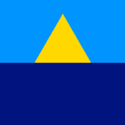Sunha
| The Federation of Sunha Sṓisana |
||||
|---|---|---|---|---|
|
||||
| Capital and largest city | Batara | |||
| Official languages | Oesana Cananganamese |
|||
| Religion | Turesaa | |||
| Demonym | Cananganamese | |||
| Government | Constitutional Theocracy | |||
| - | Emperor | Námgō nā Nágnatumī | ||
| - | Prime Minister | Duse Ovasa | ||
| - | Chief Deputy | Sahknatumi | ||
| Legislature | Sunhese Parliament | |||
| - | Upper house | Assembly of the Estates | ||
| - | Lower house | Assembly of the People | ||
| Establishment | ||||
| - | First Asuranesian Settlers | c. 2nd Century BCE | ||
| - | Beginning of Cananganamese Settlement | c. 928 | ||
| - | Independence from Cananganam | December 12, 1892 | ||
| - | AEIOU Membership | TBD | ||
| Population | ||||
| - | 2019 estimate | 79,550 | ||
| - | 2014 census | 78,263 | ||
| GDP (nominal) | estimate | |||
| - | Total | $291.763 Million | ||
| - | Per capita | $3,728 | ||
| Gini | 40.2 medium |
|||
| HDI (2019) | medium |
|||
Sunha is an island monarcho-theocracy within the Asura Ocean. The country consists of four major islands along the Sunha island chain, and 15 smaller though permanently inhabited islands. The four main islands are known from South to North as Senkayusana, Gangansana, Ngasana, and Kutuyesa; the most populated of the four islands as well as boasting the location of the country's capital. Together, the islands compose a land area less than 1,800 square kilometers, leaving its land area quite small in comparison to the majority of the countries upon Sahar. However, Sunha claims one of the largest and most disputed areas of nautical territory, claiming fishing and off shore oil drilling rights to over 3 million square kilometers of ocean. The truthfulness of these rights has been in dispute since the treaty demarcating Cananganam's release of the island chain in 1892, with the dispute seeing no end in sight with Cananganam and Sunha both disputing the right to ownership of the island of Owotau (Babatoo), the core of these claims. The nation is not part of the International Congress, despite its membership within the AEIOU.
History
The Sunha island chain was originally settled by Eastern Marianic peoples in the 2nd Century BCE, being the first permanent human inhabitants of the islands. This culture shows similar levels of technology progress to that of Littoro-Marianic peoples at this time, displaying limited knowledge of iron working but primarily working with softer metals such as copper and tin. Most tools, however, are made using bones, rocks, and local plant materials.
In 928, the first Canamic fishermen started to settle upon the islands due to its bountiful natural fisheries. This inevitably led to its inclusion within the Canamic Empire, being known as the Srunha (Easterly) islands due to their position within the Asura island chains. The first settlers, aside from fishermen, were exiled nobles and clergymen from Cananganam proper for various crimes such as murder and theft; though, some of these were made up charges meant to expel political opponents. The islands saw prosperity during the height of the Empire, though much of the local customs and language were lost, with a new Canamic language forming as a result of the stratum and its distance from Cananganam proper and no standard language body at the time.
Upon the reduction of the Empire's influence upon the Asura, Sunha gained significant autonomy and began to govern itself, though maintaining itself as a Turesaaist state. The local customs blended with Canamic ones, and eventually a distinct identity of the Sunhese people formed. By the 1700s a resurging Canamic Empire was beginning to re-establish its control over the Asura. Eventually, Sunha was absorbed back into the empire and many of the distinct customs were discriminated against for "breaking and disturbing the teachings", leading to both resentment and forced assimilation within the Cananganamese cultural zone proper. The locals, however, resisted these attempts well into the 1800s, owing to their distance from Cananganam proper. Sunha was the center of the ASS Mozoglī Gā Crisis, where upon several Cananganamese patrol ships fired upon the monitor with Athsud marines taking over the island within 46 minutes of the beginning of the engagement. Eventually, the island was afforded independence as a result of the cooperation of the islanders to the Athsud marines in their occupation, as well as their distance from Athsud. The terms of the treaty were signed in 1892 on the 12th of December.
By 1920s, several protests occurred regarding the appointment of members to governing councils, leading to Sunha adopting Vaniuan style governance which was attempt by then Prime Minister Natti to sway Balakia and Vosan to support its independence from a then politically unstable Cananganam. Sunha remained neutral throughout the GEW, owing to its isolation from the conflict zones and affording no major value to any theater of conflict at the time. By the 70s, Vosan businessmen began to invest in Sunha as a tourist destination spot, creating a theme of an oceanic paradise untouched by the outside world. Throughout the 80s, many of the islanders were conflicted by some of the views perpetrated by such businesses with most welcoming the new source of money and others opposing the monetizing of their culture; most in particular with foreigners meeting with the Emperor of Sunha, a role historically held only for those close to the Emperor in rank in Sunhese society.

